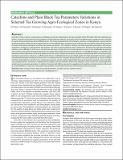| dc.contributor.author | Mose, M.T. | |
| dc.contributor.author | Ochanda, S.O. | |
| dc.contributor.author | Moseti, K.O. | |
| dc.contributor.author | Wanyoko, J.K. | |
| dc.contributor.author | Owuor, P.O. | |
| dc.contributor.author | Kinyua, J.K. | |
| dc.contributor.author | Kariuki, D. | |
| dc.contributor.author | Magiri, E.N. | |
| dc.contributor.author | Obanda, M.A. | |
| dc.date.accessioned | 2020-03-12T20:53:20Z | |
| dc.date.available | 2020-03-12T20:53:20Z | |
| dc.date.issued | 2019 | |
| dc.identifier.citation | Mose MT, Ochanda SO, Moseti KO, Wanyoko JK, Owuor PO, Kinyua JK, Kariuki D, Magiri EN, Obanda MA. Catechins and Plain Black Tea Parameters Variations in Selected Tea Growing Agro-Ecological Zones in Kenya. International Journal of Tea Science 2019;14(1):49-55 | en_US |
| dc.identifier.issn | DOI: 10.20425/ijts1417 | |
| dc.identifier.uri | https://repository.maseno.ac.ke/handle/123456789/1488 | |
| dc.description.abstract | Over 60% of tea in Kenya is produced by smallholder tea farmers distributed in the East and West of the Rift Valley. With all smallholder tea farmers using the same production technologies including planting materials, the quality of tea from different agro-ecological zones should be the same. However, black teas attract different prices. This study compared levels of leaf quality, catechins, and polyphenols in green leaf and quality parameters of black tea from twelve factories in three different agro-ecological zones in Kenya and assessed the relationships between the green leaf quality parameters and black tea quality parameters. The catechins contents, the black tea quality parameters, and sensory evaluations changed (p ≤0.05) between the factories and with an agro-ecological zone of production. All black teas had high antioxidant activities, which differed (p ≤0.05) across the factories and zones. Despite the use of same agronomic inputs in the smallholder tea growing zones in Kenya, the quality of resultant black teas was largely influenced by the environmental factors in the different regions. It is therefore not possible to produce black teas of the same quality across the country. Despite the variations, all regions exhibited high levels of black tea quality parameters and sensory evaluation, re-affirming the Kenyan smallholder black teas are of high quality. The high antioxidant activities suggest possible beneficial pharmacological activities from consumption the teas. The green leaf quality (leaf count) were significantly (p ≤0.05) correlated with black tea brightness and all sensory evaluation parameters, demonstrating high benefits from good plucking standards. Green leaf gallic acid, epigallocatechin, epicatechin, epigallocatechin gallate, and total catechins levels were related (p ≤0.05) to black tea total polyphenols and all sensory evaluation parameters. In addition, the green leaf caffeine, epicatechin, epigallocatechin gallate, and total catechins influenced (p ≤0.05) theaflavins in black tea. These green leaf parameters are therefore key drivers of Kenyan plain black tea quality. | en_US |
| dc.description.sponsorship | National Commission for Science, Technology, and Innovation (NACOSTI), Kenya | en_US |
| dc.language.iso | en | en_US |
| dc.publisher | International Society of Tea Science | en_US |
| dc.subject | Agro-ecological zones, Black tea quality parameters, Camellia sinensis, Catechins, Kenya | en_US |
| dc.title | Catechins and Plain Black Tea Parameters Variations in Selected Tea Growing Agro-Ecological Zones in Kenya | en_US |
| dc.type | Article | en_US |

